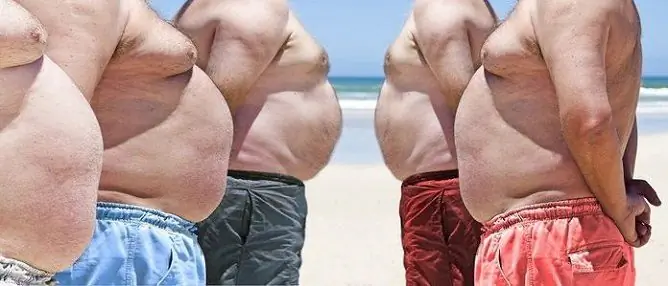- Author Rachel Wainwright [email protected].
- Public 2023-12-15 07:39.
- Last modified 2025-11-02 20:14.
Testicles
Testicular structure
Testicles (testis, testes) - sex glands in men. The testicles are located at the bottom of the scrotum.

The testicle has an ellipsoidal shape somewhat flattened from the sides. The testicle is about 4.5 cm long, about 3 cm wide, and about 2 cm thick. The testicles are suspended on the spermatic cord, with the left one slightly lower than the right one. At the posterior edge of each testicle is an epididymis, epididymis.
The testes in men consist of a parenchyma enclosed in a dense white membrane formed by connective tissue. From the tunica albuginea in the parenchyma of the gland there are septa that divide the testicle into lobules. The septa are located radially, from the front edge, as well as the lateral surfaces, directed to the rear edge. Each gland contains 100-250 such lobules. Each lobule contains convoluted seminiferous tubules. The tubules are lined with spermatogenic epithelium, consisting of Sertoli cells, on which spermatozoa - sex cells in men - develop.
The testicle with the epididymis is covered with a vaginal membrane that forms a closed serous cavity. The testicles are intraperitoneal organs (located intraperitoneally), and are covered with a visceral plate, which passes into the parietal one along the posterior edge of the organ. The visceral plate with the tunica albuginea is spliced quite firmly, only at the posterior edge, passing to the appendage, the membrane leaves an uncovered area. At this point, the vessels and nerves enter the gland.
In the parenchyma of the testicles, between the tubules are Leydig cells that produce testosterone.
The epididymis is a narrow, long, paired formation that lies along the posterior edge of the gland. The appendage forms the bulk of the vas deferens. The appendage has an upper part (head of the epididymis), a middle part (body of the epididymis), a lower part (tail of the epididymis), continuing into the duct of the epididymis. The duct of the epididymis passes directly into the vas deferens.
Testicles in men initially develop in the abdominal cavity, in the prenatal period they gradually move downward, by the time of delivery, located in the scrotal cavity. This movement is associated with the peculiarities of spermatogenesis: the process of sperm formation is carried out at a temperature 3-4 ° C lower than body temperature.
The transfer of the testicle into the scrotum in the prenatal period leads to some anatomical features. When passing through the inguinal canal, the testicle carries away the peritoneum and muscles of the abdominal wall, while the muscular and vaginal membranes are formed. The presence of the muscular membrane provides the ability to pull the testicle to the inguinal canal.
When the testicle is carried away during the movement of the parietal peritoneum, the vaginal process of the peritoneum is formed. At the site along the spermatic cord, by the time of delivery, the vaginal process of the peritoneum is overgrown, and a closed cavity is formed. With its non-closure, a congenital inguinal hernia or a communicating dropsy of the testicle is formed. With the accumulation of fluid inside the closed cavity of the vaginal membranes of the testicle, a true hydrocele of the testicle forms - a hydrocele.
Functions of the testicles and appendages
The main functions of the testes are testosterone production and sperm formation. The functions of the epididymis are to carry sperm into the vas deferens, as well as to carry out the process of sperm maturation.
Pain in the testicles
One of the common symptoms of various diseases in men is testicular pain. The reason for the appearance of such a symptom may be the following diseases:
- testicular torsion is a pathology in which the testicle rotates around its axis in the scrotum. As a result, the blood supply to the spermatic cords is interrupted. A feature of the pain syndrome in this pathology is its high intensity, the appearance of pain on one side is also characteristic;
- torsion of testicle weight gain - torsion of the rudimentary residue located in the region of the upper pole of the testicle. This is characterized by pain in the upper part of the organ;
- trauma - post-traumatic testicular pain can be a symptom of testicular rupture, hematocele (accumulation of blood inside the scrotum), hematoma;
- infringement of an inguinal hernia - occurs against the background of a long-existing hernia; pain develops suddenly, is characterized by high intensity;
- orchitis is an inflammation of the testicle, usually of a viral nature. Characterized by reddening of the scrotum, unilateral or bilateral pain in the testicle, increased body temperature;
- epididymitis - inflammation of the epididymis.
Pain in the testicles can be a symptom of other diseases of a general somatic nature, but in any case, the appearance of such a symptom should be a reason for immediate seeking qualified help, since in a number of diseases, the prognosis directly depends on timely treatment.
Testicular cyst
A fairly common pathology is a testicular cyst. Testicular cysts are found in about 30% of patients undergoing ultrasound of the scrotum for various reasons. This pathology is a benign hollow formation, located mainly near the epididymis, in which the fluid component accumulates. More often, cysts are located in the region of the epididymis head, but can be localized along the vas deferens. Cysts are usually well seen on physical examination. With a significant size of the cyst, discomfort, stretching of the scrotum, surgical intervention is required.
The causes of testicular cysts are still unknown. There are suggestions that cysts arise from the vas deferens or are aneurysmal enlargement of the epididymis.
Small cysts are asymptomatic and are usually found during routine examination or self-examination.
The main treatment for testicular cysts is surgery. However, it is not necessary for asymptomatic cysts. Studies have also been conducted on the use of sclerosing drugs, but there is no reliable data confirming the effectiveness of a particular drug. Removal of the cyst is a simple operation, usually performed on an outpatient basis, under local or general anesthesia.
Found a mistake in the text? Select it and press Ctrl + Enter.






